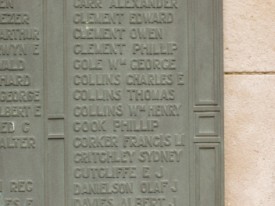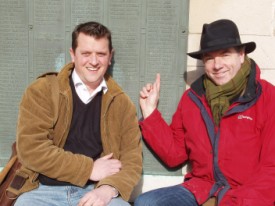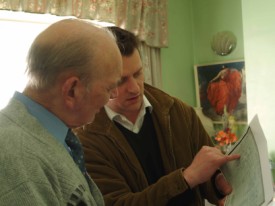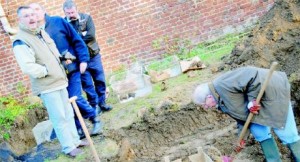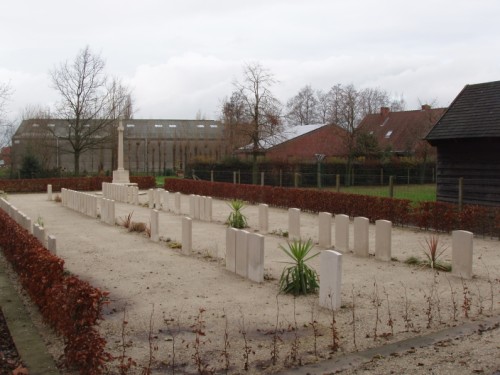Archive for 2010
Free design work – in praise of OMB Direct
Just had to write a few lines to praise to the heavens the Bristol-based design team, OMB Direct. I was put in touch with them by my wife who had done some work with them before and approached them with regard to doing the design work for a (2x1m) information panel that we are getting done for the Tunnellers Memorial www.tunnellersmemorial.com. I thought they may offer us a good rate but was bowled over when, on hearing about the project, they offered their services completely for free!
So far they have sent us revised editions as we provide more pictures and text – throughout they have been brilliantly helpful and I think the finished article is superb. It will explain the story of William Hackett and Thomas Collins and a little about the Tunnelling Companies along with great pictures and a fantastic line drawing of the incident in which the two men lost their lives.
So, a big thanks to Chris and Sharon for their design skill and help plus their wonderful generosity and sheer good nature. I would recommend them to anyone. www.ombdirect.co.uk
John Abraham is one of the nephews of Thomas Collins. He read of our appeal to trace any family descendants in the South Wales Evening Post of 1 March and called me a few days later. The phone call was a very special moment as I had worked so hard to trace him and, as he mentioned his relationship to the Collins family members and I recognised every name from the 1911 census records, I realised that my search had been rewarded. For a researcher, this was a Eureka moment which had quite an effect on me.
Following a number of phone calls with John and BBC Wales (who covered the story for the regional news) Peter Barton and I travelled to Swansea on Friday 12 March to meet up. We met the BBC at the Swansea Cenotaph to view Thomas Collins’ name on the memorial. 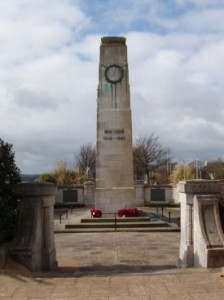
It felt strange seeing his name (and that of his brother Daniel who had died in 1918 whilst serving with the RNVR) and knowing that we would soon meet a descendant of his. The BBC did their filming there and we then headed to Thomas’ old address that he enlisted from (50 Shelley Crescent – now renamed as High View) where I was interviewed for BBC Radio Wales. Next up was Colbourne Terrace where the Collins family moved to post-war (Thomas’ youngest brother William lived at No.58 until his death in the 1990s).
Our last and most moving stop was our visit to John’s house (all of a mile or so from Colbourne Terrace) where we were welcomed in. John had mentioned that Thomas’ mother had had a large picture of Thomas but I never imagined what I would find. It really is the most incredible 3ft x 2ft framed picture of Private Thomas Collins in khaki with cards that he sent home from France stuck around the outside of the frame. This painted picture, although in need of a good clean up, had incredibly vivid colours. It had sat in Thomas’ mother’s parlour for the rest of her lifetime (along with one of Daniel Collins). These remarkable pictures were clearly treasured possessions and a real tribute to her two eldest boys lost in the war. We had a good long chat with John, some on camera for the Beeb, but mostly after they had left. John indicated that he would be delighted to attend the memorial unveiling on 19 June along with other members of his family. I am sure that day will be an incredible experience and can only imagine what it will be like to see relatives of Sapper William Hackett VC and Private Thomas Collins standing together at the spot where their family members still lie 40 feet beneath the Givenchy clay. As ever, please visit the News & Fund Raising section of http://www.tunnellersmemorial.com/ for further details and to see the picture of Thomas Collins. Please click for a video of the BBC Wales News piece on our meeting John Abraham
Great War Portraits
I had a lunch yesterday in London with friends from Genesta Battlefield Club and was introduced to Keith Collman. Keith is a photographer with a keen interest in Great War veterans. His face seemed familiar and as he pointed out to me that we had met on a battlefield trip to Ypres in 2002 the recollections of that trip slowly came back to me. Keith had been travelling with us when we had taken Jack Davis, Harry Patch and Arthur Halestrap back to Ypres for Armistice commemorations. I recalled that he has been snapping away through the trip so wasn’t surprised to hear about his photographic project.
For the past 25 years he has been taking black & white portrait photographs of veterans. He realised that he had a remarkable collection and that he had better preserve these for posterity. (He mentioned that his children wouldn’t know what all the negatives were and would probably bin them on his demise!) The result of his endeavour is a superb book entitled ‘Great War Portraits’. I bought a copy (priced £25) and it is a lovely quality book to flick through – a real tribute to these remarkable gentlemen that we all owe so much to. Some of them I had had the pleasure of knowing, some I had never met but seen on TV documentaries whilst there are others whose faces were new to me. All are beautifully photographed and there are good details of all the men featured.
Keith has only produced 1000 copies and hopes one day to be able to get his money back – it is certainly not a profit making venture. His website http://www.greatwarportraits.com/ gives a really good idea of the quality of product and is a very nice read in itself. Highly recommended for those who want a memento of these wonderful men.
It was reported in November 2009 that the bodies of fifteen men from the York and Lancaster Regiment were found in the French village of Beaucamps-Ligny. It seems likely that these men (from the 2nd Battalion) were killed in the fighting of 18 October 1914 and their bodies lay undisturbed until found by workmen working on a building site. Apparently their regiment has been determined from surviving buttons.
There are two things about this discovery that I want to comment on. Firstly, I will be most interested to see what decision is made about using DNA samples to try and identify these bodies. The decision to excavate the mass grave at Pheasant Wood, Fromelles and use DNA in the aim of establishing identities for the remains now means that a precedent has been set. It would be unthinkable that DNA testing be carried out on the Pheasant Wood remains but denied to the bodies of the York & Lancs men found at Beaucamps-Ligny. After all, only it is less than three miles between Fromelles and Beaucamps-Ligny. I would be amazed if the CWGC refused DNA testing for these remains, especially considering the high probability of successful identification. These fifteen remains amount to nearly half of the known ‘missing’ of that Battalion when in that area. Pitting this against the Pheasant Wood mass grave where the chance of successful identification is much less, there is simply no way that the CWGC can refuse DNA techniques. It certainly means that a real can of worms is now open. Fromelles was always going to be a test case – having announced that the usual “decisions regarding investigation or attribution of identity are a matter for the relevant service authority – in this case the United Kingdom Ministry of Defence and their Joint Casualty and Compassionate Centre” it will be fascinating to see the long-term CWGC response for this and other cases.
Secondly, I know I was not alone in being disgusted at photographs published in the French newspapers of the remains being excavated. A group of Frenchmen surrounded a hole in the ground. Another colleague was digging into the skeletal remains. I should think a few archaeologists shuddered when they saw that photo. It is simply unbelievable that the remains of fifteen men can be removed in such a way. The whole process should have been done archaeologically – in a systematic and dignified way as opposed to the (frankly awful) mess as seen on the photos. Even a the most casual viewer of television programmes such as ‘Time Team’ & ‘CSI’ would know that bodies are removed delicately, layer after layer – most definitely not by having a workman’s spade dug straight into a mass of bones. The pictures show a shameful scene – at the graveside is Martial Delebarre – curator of the Fromelles Museum and member of the Association Souvenir de la Bataille de Fromelles. It is simply beyond belief that someone with his knowledge and position in local matters can stand idly by and watch this amateurish excavation without thinking to halt it and call in professional archaeologists.
It is about time that standardised and proper archaeological practices surrounding the finding of human remains on the old battlefields are brought in so we do have to witness a mess like this again. I know I am not alone in this opinion. Surely this is the least these men deserve?
Spreading the word – Tunnellers Memorial
I have been busy this week with publicising the Tunnellers Memorial. This is to be unveiled on Saturday 19 June and we would like as big an attendance there as possible. We certainly don’t want charges of ‘I would have come but wasn’t aware of it’ levelled at us – the more people who know, the better as far as we are concerned.
Knowing the huge number of police officers interested in the Great War, I contacted NARPO who were very helpful and added a piece to their News Section. The Guild of Battlefield Guides did likewise. There followed the large task of contacting as many regimental museums as possible with the aim that they spread the word to their contacts. So far I have had some really positive responses back and people seem genuinely delighted with the proposed memorial. Next up is to contact the various contacts in the South Wales press and TV with the aim of publicising our search for descendants of Private Thomas Collins of Swansea. Collins was the wounded man who Hackett refused to leave and it would be fantastic to trace any family members to attend the unveiling ceremony. More news on this as and when…
WFA, Avon Branch Talk – Vera Brittain
I went to my first WFA meeting at the Avon Branch in Kingswood last night to hear a talk given by Michelle Young on Vera Brittain in the Great War. Despite a mad dash to get there in time and arriving with literally a minute to spare I was made very welcome and really enjoyed the talk. As I sat there listening a good amount of the detail of Vera Brittain’s life came back to me – I had read her work, Testament of Youth and the Letters from a Lost Generation ‘First World War Letters of Vera Brittain and Four Friends’ edited by Alan Bishop and Mark Bostridge over ten years ago.
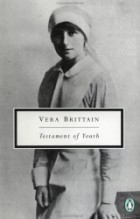 The loss she endured through the war, losing her fiancée Roland Leighton at Christmas 1915, two friends Victor Richardson and Geoffrey Thurlow in 1917 and her own brother Edward in 1918 does not even bear thinking about. Michelle clearly had empathy with the subject and had visited many of the locations associated with Vera’s life as well as the graves of men she had known. Despite being a member for some time it was my first visit to a WFA talk and was a great experience. Having received a list of talks planned for 2010 I look forward to further visits.
The loss she endured through the war, losing her fiancée Roland Leighton at Christmas 1915, two friends Victor Richardson and Geoffrey Thurlow in 1917 and her own brother Edward in 1918 does not even bear thinking about. Michelle clearly had empathy with the subject and had visited many of the locations associated with Vera’s life as well as the graves of men she had known. Despite being a member for some time it was my first visit to a WFA talk and was a great experience. Having received a list of talks planned for 2010 I look forward to further visits.
CWGC climate change trials
Back in early December I spent a long day on a research jaunt to Ypres with friends and colleagues Peter Barton and Nigel Steel. We had a number of stops planned but still had time to stop in at Railway Chateau Cemetery to witness first-hand the experimental work carried out there. This work, in the words of the CWGC meant the “cemetery has completed its transformation: geotextile and a dolomite limestone surface have been laid and borders planted.” What this means is that the grass has been removed and a part-gravel, part hardcore put in its place. I noticed that the surface has been rollered with no care at all and it was easy to see and feel underfoot the rise and fall of the ground where the aggregate has been pushed. The plants looked in a sorry state and the whole place has the air of desolation about it. The worst bit was that the surface is a compromise – it was neither pea shingle or hard standing. So, the surface moves under your feet and it is easy to kick divots out of it (as happened when Nigel nearly tripped over).
The CWGC visitors’ book was terrifyingly like reading the Daily Mail but, for once, I agreed with the sentiments written. They have made a beautiful cemetery look a right mess. One can only hope that they regard this purely as an experiment. CWGC info on the project is available here.
Following a nod from some kind soul on the Great War Forum I spent a few happy hours downloading free books from the excellent website: http://www.archive.org/
I had come across this site in the past when Googling for various books and had downloaded a few over the years. However, that was on a ‘as you need them’ basis. I had never sat down and really searched for Great War content available – and all for free!
It is amazing what is available and I have downloaded over 70 books in pdf format (totalling over 1GB). These range from personal memoirs I had never heard of before through to regimental, brigade and divisional histories. And the best bit? As they are in pdf format, it is easy to search for specific words. This makes research that much easier. However, don’t expect to see daylight for days. Searching for “1914-1918” yields over 10, 000 results! A pat on the back from me to all those who scan these books so we can all share the knowledge.

